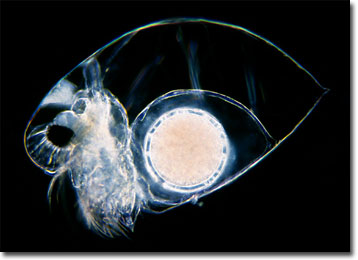Wim van Egmond
Water Flea
Though some of the primarily microscopic organisms appear to hop through their aquatic environments, water fleas are more closely related to lobsters and crabs than the blood-sucking terrestrial insects of the order Siphonaptera that they are named after. The tiny crustaceans are, however, sometimes considered pests by humans who fear large populations of the plankton-eaters could starve out small feeder fish and adversely affect the fishing industry.

Distributed worldwide, approximately 450 species of water fleas have been identified. The vast majority of the organisms are only found in freshwater, but a small handful can survive in the sea. These marine species may, however, appear quite different than their inland relatives. Typically, water fleas feature a discrete head, a compound eye, pronounced antennae, and a protective carapace that surrounds the trunk and abdomen. The carapace, which appears to be composed of two separate sections although it is actually formed from a single piece, may sometimes enclose the head as well, and in at least one species is significantly reduced in size. Reaching lengths as great as 18 millimeters, the predatory water flea Leptodora seems to have outgrown the traditional carapace, but retains the truncated structure as a brood sac.
The most commonly known water fleas are those that belong to the genus Daphnia. Frequent inhabitants of the ponds and streams of North America and Europe, the cladocerans primarily reproduce parthenogenetically, but in times of impending stress may switch to sexual methods of proliferation. A variety of environmental cues apparently cause this important change, which results in resilient eggs that can withstand freezing, drying, and other harsh conditions. Daphnia are capable of reacting in other ways to factors in their surroundings, as well. Some species, for instance, develop a protective helmet-like structure in response to chemicals called kairomones released by certain predators. Others may adopt dwarf forms that are small enough to pass through the gill rakers of various fish when levels of predator waste materials in the water are high.
BACK TO WIM VAN EGMOND GALLERY
